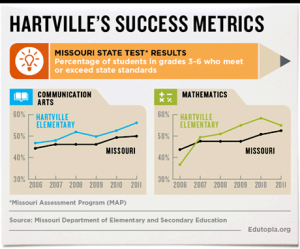High-Impact Professional Development for Rural Schools
This high-quality professional development program consisting of 200 hours of training spread over two years has consistently demonstrated positive impacts on student achievement.
I talk with a lot of teachers about how they become fulfilled or, in too many cases, frustrated in their profession. It isn't long in these conversations before the words "professional development" come up. You can practically set your watch to it. And I've discovered that where you find enthusiastic teachers enjoying persistent classroom success, you will find sustained, collaborative, educator-directed PD programs.
This month Edutopia focuses on professional development at a small rural elementary school in southwest Missouri. The school is Hartville Elementary School, in the town of Hartville (population 613). The program is called eMINTS and is produced by a nonprofit, Missouri-based professional-development organization of the same name. For 12 years, eMINTS, which stands for Enhancing Missouri's Instructional Networked Teaching Strategies, has been educating teachers and other learning professionals about how to use technology to enhance inquiry-based learning in K-12 classrooms. They have trained more than 3,700 educators throughout the state of Missouri and in districts in Alabama, Arkansas, Connecticut, Delaware, Illinois, Maine, Nevada, New Jersey, Oklahoma, Texas, and Utah, as well as in New South Wales, Australia.
The eMINTS professional-development program consists of as many as 200 hours of learning time, spread over a two-year period, including in-classroom coaching and follow-up training sessions. The results indicate that it's time well spent. About 250,000 students have been taught by eMINTS-trained teachers over the past ten years. According to research from the Education Development Center and the Missouri Office of Social and Economic Data Analysis (cited in Learning Point Associates, 2010) those students attending Missouri schools which received training from eMINTS consistently out-performed their statewide counterparts in state standardized tests.
A Cultural Shift
But there's more to it than teaching teachers how to use technology. "We want to help teachers learn to be learners again," says eMINTS National Center executive director Monica Beglau. "We want to help them move away from being the people who hold all the knowledge to being the people who actually sit alongside -- not in front of -- their students and become facilitators of learning while continuing to learn themselves."
I asked Tonya Wilson about it. She is a sixth-grade teacher at Hartville Elementary School. For years, the school was struggling with a lack of tech resources and a dearth of professional-development opportunities -- until 2005, when the Hartville R-II District implemented the eMINTS program in grades 3-8. "We didn't have a lot of money or a lot of economic opportunity in Hartville," Wilson says. "But what we've always had is an amazing school, where we are determined to prepare our kids for a different kind of economic future."
So after her school secured a grant to purchase essential tech tools like classroom computers and interactive whiteboards, Wilson embarked on her two-year eMINTS PD experience. She and other educators from the Hartville district gathered once a week for up to four hours of training throughout the school year. "eMINTS focused us on how to teach skills relevant to our kids' futures, from things as simple as transforming a lesson to the whiteboard to how to use Web-based tools like Animoto or GoAnimate to make videos," she reports.
(MORE: sample PD materials and other resources from eMINTS below)
Teacher Engagement
Method-wise, eMINTS trainers are very deliberate in creating a learning dynamic like the one they want the teachers to develop in their classrooms. The aim is to make the teachers students again, right down to the groups they work in, the eye contact they must make with their trainers, and the group presentations they deliver to prove out their learning.
Not all the training is tightly focused on technology, though most sessions follow a similar format. A typical PD session, in this case about creativity, unfolds something like this:
- First 15 minutes: Teachers get settled and the trainer leads them through a fun collective exercise, e.g., each participant picks an image from a group of pictures (famous paintings, wild animals, landscapes) that depicts their feelings about their progress in digesting their eMINTS training experience.
- Next 30 minutes: The class views a video of creativity expert Sir Ken Robinson on building a creative classroom culture. Discussion follows about how to put the ideas into practice.
- Next 70 minutes: The class divides into groups, and each group uses simple materials to construct a product inspired by Robinson's words. Groups reflect on the process and draw conclusions about how to implement a similar project in their classrooms.
- Next 50 minutes: The class focuses on how to develop an assessment tool to measure creativity, and teams reflect on how to use the tool in their classrooms.
- Final 15 minutes: Participants redo the pick-an-image exercise, this time to reflect their feelings about what they've learned about creativity, followed by closing thoughts on how they will implement what they've learned that day in their classrooms.
Four Essentials to Successful PD
Asked to boil down what makes eMINTS PD successful, Monica Beglau is succinct:
- Duration: Aim for 40 to 50 hours per year, and not in bunches but comfortably spaced out across the calendar so teachers have enough time to digest what they've learned and experiment in their classrooms.
- Coherence: Training must be explicitly connected to classroom practices as well as in sync with what the district, the principal, and the teacher believe is important to success.
- Relevance: Training must be applicable in the classroom right away; principals should provide the support and tools required for teachers to put their training into action.
- Coaching: Have an instructional specialist available periodically in the classroom to provide support and suggestions as the teacher tries new strategies.
The cost of the program, according to Beglau, is approximately $22,000 per classroom to implement a full and comprehensive program, including all the technology (hardware and software), teacher training, in-classroom trainer support, extensive resources, and follow-up. Introductory and shorter programs for less than $100 per class are also available.
Consistent Results
According to a Learning Point Associates study in 2010, ten years of eMINTS PD research has consistently demonstrated that the program increases teachers' use of technology to support inquiry-based learning, and students in grades 3-6 who receive this high-quality, technology-integrated instruction outperform students who do not.

Mark Piper, the principal at Hartville, has been more than pleased with the results. "By helping our teachers with training they can apply directly in their classrooms, we not only improved our test results, we changed the entire culture of our school. And our focus has grown from improvement to excellence." Research confirms that building a culture in which teachers support and encourage each other in the use of technology helps promote lasting changes in their practice (Levin & Wadmany, 2008).
With successes like these to point to, one can't help but wonder why, when we provide many diverse professional-development opportunities for other professions in America, we can't do more for our educators. eMINTS is just one of many PD strategies that work, and research is bringing more winning options to light every day. Yes, some money and resources are required. But can you think of a better return on investment than the success of Tonya Wilson's sixth graders in Hartville, Missouri?
Resources and Downloads
Educators from eMINTS have shared these resources for tech integration and PD.
- Sample PD Facilitator's and Teacher's Guides (To obtain complete copies of any of the samples, please contact eMINTS.)
